Timor Leste Defence Force
The Timor Leste Defence Force (Tetum: Forcas Defesa Timor Lorosae, Portuguese: Forças de Defesa de Timor Leste or Falintil-FDTL, often F-FDTL) is the military body responsible for the defence of East Timor. The F-FDTL was established in February 2001 and comprises two infantry battalions, small naval and air components and several supporting units.
| Timor-Leste Defence Force | |
|---|---|
| Falintil-Forças de Defesa de Timor Leste | |
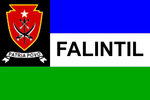 F-FDTL flag | |
| Founded | 2001 |
| Service branches | Timor-Leste Army Timor-Leste Naval Component Timor-Leste Air Component |
| Headquarters | Dili |
| Leadership | |
| President | Francisco Guterres |
| Minister for Defence and Security | Filomeno Paixão |
| Commander, Timor-Leste Defence Force | Major General Lere Anan Timor |
| Manpower | |
| Military age | 18 |
| Available for military service | 299,008 males, age 16–49 (2010 est), 286,465 females, age 16–49 (2010 est) |
| Fit for military service | 236,996 males, age 16–49 (2010 est), 245,033 females, age 16–49 (2010 est) |
| Reaching military age annually | 12,795 males (2010 est), 12,443 females (2010 est) |
| Active personnel | 2,280 (IISS, 2020)[1] |
| Reserve personnel | None |
| Expenditures | |
| Budget | $US31.1 million (2019)[1] |
| Industry | |
| Domestic suppliers | None |
| Foreign suppliers | Donations from foreign governments, mostly Australia, China, Indonesia, Malaysia and Philippines |
| Related articles | |
| Ranks | Military ranks of East Timor |
The F-FDTL's primary role is to protect East Timor from external threats. It also has an internal security role, which overlaps with that of the Policia Nacional de Timor Leste (PNTL). This overlap has led to tensions between the services, which have been exacerbated by poor morale and lack of discipline within the F-FDTL.
The F-FDTL's problems came to a head in 2006 when almost half the force was dismissed following protests over discrimination and poor conditions. The dismissal contributed to a general collapse of both the F-FDTL and PNTL in May and forced the government to request foreign peacekeepers to restore security. The F-FDTL is currently being rebuilt with foreign assistance and has drawn up a long-term force development plan.
Role
The constitution of East Timor assigns the F-FDTL responsibility for protecting East Timor against external attack. The constitution states that the F-FDTL "shall guarantee national independence, territorial integrity and the freedom and security of the populations against any aggression or external threat, in respect for the constitutional order." The constitution also states that the F-FDTL "shall be non-partisan and shall owe obedience to the competent organs of sovereignty in accordance with the Constitution and the laws, and shall not intervene in political matters." The National Police of East Timor (or PNTL) and other civilian security forces are assigned responsibility for internal security.[2] In practice the responsibilities of the F-FDTL and PNTL were not clearly delineated, and this led to conflict between the two organisations.[3]
The East Timorese Government has broadened the F-FDTL's role over time. As what have been designated "new missions", the F-FDTL has been given responsibility for crisis management, supporting the suppression of civil disorder, responding to humanitarian crises and facilitating co-operation between different parts of the government.[4]
History
Pre-independence
The F-FDTL was formed from the national liberation movement guerrilla army known as FALINTIL (Portuguese acronym for Forças Armadas de Libertação de Timor-Leste or Armed Forces for the Liberation of East Timor). During the period before 1999 some East Timorese leaders, including the current President José Ramos-Horta, proposed that a future East Timorese state would not have a military. The widespread violence and destruction that followed the independence referendum in 1999 and the need to provide employment to FALINTIL veterans led to a change in policy, however.[5] Following the end of Indonesian rule, FALINTIL proposed the establishment of a large military of about 5,000 personnel.[6]
In mid-2000 the United Nations Transitional Administration in East Timor (UNTAET) invited a team from King's College London to conduct a study of East Timor's security force options. The team's report identified three options for an East Timorese military. Option 1 was based on FALINTIL's preference for a relatively large and heavily armed military of 3,000–5,000 personnel, option 2 was a force of 1,500 regulars and 1,500 conscripts and option 3 was for a force of 1,500 regulars and 1,500 volunteer reservists.[7] The study team recommended option 3 as being best suited to East Timor's security needs and economic situation. This recommendation was accepted by UNTAET in September 2000 and formed the basis of East Timor's defence planning.[5][Note 1] The plan was also accepted by all the countries that had contributed peacekeeping forces to East Timor.[9] The King's College report has been criticised on the grounds that it led East Timor to establish a large police force and a large Army when its security needs may have been better met by a single smaller paramilitary force.[10]
While East Timor's decision to form a military has been criticised by some commentators,[11] the East Timorese government has consistently believed that the force is necessary for political and security reasons. Critics of the F-FDTL's establishment argue that as East Timor does not face any external threats the government's limited resources would be better spent on strengthening the PNTL. While East Timor's political leadership recognises that the country does not currently face an external threat, they believe that it is necessary to maintain a military capacity to deter future aggression. The establishment of the F-FDTL was also seen as an effective means of integrating FALINTIL into an independent East Timor.[12]
Formation of the F-FDTL
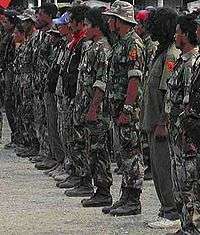
FALINTIL officially became F-FDTL on 1 February 2001. The first 650 members of the F-FDTL were selected from 1,736 former FALINTIL applicants and began training on 29 March. The FDTL's 1st Battalion was established on 29 June 2001 and reached full strength on 1 December. Most members of the battalion were from East Timor's eastern provinces.[13] The 2nd Battalion was established in 2002 from a cadre of the 1st Battalion and was manned mainly by new personnel under the age of 21 who had not participated in the independence struggle.[14] Due to the force's prestige and relatively high pay, there were 7,000 applications for the first 267 positions in the battalion.[15] The F-FDTL's small naval component was established in December 2001.[16] The Australian UNTAET contingent provided most of the F-FDTL's training, and the United States equipped the force.[17]
Some of the problems that have affected the F-FDTL throughout its existence were caused by the process used to establish the force. A key flaw in this process was that FALINTIL's high command was allowed to select candidates for the military from members of FALINTIL without external oversight. As a result, the selection was conducted, to a large degree, on the basis of applicants' political allegiance. This led to many FALINTIL veterans feeling that they had been unfairly excluded from the military and reduced the force's public standing.[18] Furthermore, UNTAET failed to establish adequate foundations for the East Timorese security sector by developing legislative and planning documents, administrative support arrangements and mechanisms for the democratic control of the military. These omissions remained uncorrected after East Timor achieved independence on 20 May 2002.[19]
The F-FDTL gradually assumed responsibility for East Timor's security from the UN peacekeeping force. The Lautém District was the first area to pass to the F-FDTL in July 2002. After further training the F-FDTL took over responsibility for the entire country's external security on 20 May 2004, although some foreign peacekeepers remained in East Timor until mid-2005.[20] The F-FDTL conducted its first operation in January 2003 when an army unit was called in to quell criminal activity caused by west Timorese militia gangs in the Ermera district. While the F-FDTL operated in a "relatively disciplined and orderly fashion" during this operation, it illegally arrested nearly 100 people who were released 10 days later without being charged.[21]
The F-FDTL has suffered from serious morale and disciplinary problems since its establishment.[22] These problems have been driven by uncertainty over the F-FDTL's role, poor conditions of service due to limited resources, tensions arising from FALINTIL's transition from a guerrilla organisation to a regular military and political and regional rivalries. The F-FDTL's morale and disciplinary problems have resulted in large numbers of soldiers being disciplined or dismissed.[23] The East Timorese Government was aware of these problems before the 2006 crisis but did not rectify the factors that were contributing to low morale.[24]
Tensions between the F-FDTL and PNTL have also reduced the effectiveness of East Timor's security services. During 2003 and 2004, members of the police and F-FDTL clashed on a number of occasions, and groups of soldiers attacked police stations in September 2003 and December 2004.[24] These tensions were caused by the overlapping roles of the two security services, differences of opinion between members of East Timor's leadership and the fact that many members of the PNTL had served with the Indonesian National Police prior to East Timor's independence while the F-FDTL was based around FALINTIL.[25] In 2003, the East Timorese Government established three new paramilitary police forces equipped with modern weapons. The formation of these units led to dissatisfaction with the Government among some members of the F-FDTL.[25]
2006 crisis
| External image | |
|---|---|
The tensions within the F-FDTL came to a head in 2006. In January, 159 soldiers from most units in the F-FDTL complained in a petition to then President Xanana Gusmão that soldiers from the east of the country received better treatment than westerners. The 'petitioners' received only a minimal response and left their barracks three weeks later, leaving their weapons behind.[27] They were joined by hundreds of other soldiers and on 16 March the F-FDTL's commander, Brigadier General Taur Matan Ruak, dismissed 594 soldiers, which was nearly half of the force.[24] The soldiers dismissed were not limited to the petitioners, and included about 200 officers and other ranks who had been chronically absent without leave in the months and years before March 2006.[27]
The crisis escalated into violence in late April. On 24 April, the petitioners and some of their supporters held a four-day demonstration outside the Government Palace in Dili calling for the establishment of an independent commission to address their grievances. Violence broke out on 28 April when some of the petitioners and gangs of youths who had joined the protest attacked the Government Palace. The PNTL failed to contain the protest and the Palace was badly damaged. After violence spread to other areas of Dili, Prime Minister Mari Alkatiri requested that the F-FDTL help restore order. Troops with no experience in crowd control were deployed to Dili on 29 April and three deaths resulted. On 3 May Major Alfredo Reinado, the commander of the F-FDTL's military police unit, and most of his soldiers including Lt Gastão Salsinha abandoned their posts in protest at what they saw as the army's deliberate shooting of civilians.[28]
Fighting broke out between the remnants of the East Timorese security forces and the rebels and gangs in late May. On 23 May Reinado's rebel group opened fire on F-FDTL and PNTL personnel in the Fatu Ahi area. On 24 May F-FDTL personnel near the Force's headquarters were attacked by a group of rebel police officers, petitioners and armed civilians. The attack was defeated when one of the F-FDTL naval component's patrol boats fired on the attackers.[29] During the crisis the relationship between the F-FDTL and PNTL had deteriorated further, and on 25 May members of the F-FDTL attacked the PNTL's headquarters, killing nine unarmed police officers.[24]
As a result of the escalating violence the government was forced to appeal for international peacekeepers on 25 May. Peacekeepers began to arrive in Dili the next day and eventually restored order. A total of 37 people were killed in the fighting in April and May and 155,000 fled their homes. A United Nations inquiry found that the interior and defence ministers and the commander of the F-FDTL had illegally transferred weapons to civilians during the crisis and recommended that they be prosecuted.[30]
Force development plans
The 2006 crisis left the F-FDTL "in ruins".[31] The F-FDTL's strength fell from 1,435 in January 2006 to 715 in September and the proportion of westerners in the military fell from 65 percent to 28 percent.[19] The F-FDTL started a rebuilding process with support from several nations and the United Nations, but was still not ready to resume responsibility for East Timor's external security two years after the crisis.[31]
In 2004 the commander of the F-FDTL formed a team, which included international contractors, to develop a long-term strategic vision document for the military. This study was supported by the Australian Government.[32] The resulting Force 2020 document was completed in 2006 and made public in 2007.[33] The document sets out an 'aspirational' vision for the development of the F-FDTL to 2020 and beyond and is of equivalent status to a defence white paper. It proposes expanding the military to a strength of 3,000 regular personnel in the medium term through the introduction of conscription. It also sets longer-term goals such as establishing an air component and purchasing modern weapons, such as anti-armour weapons, armoured personnel carriers and missile boats, by 2020.[34]
The Force 2020 plan is similar to option 1 in the King's College report. The King's College study team strongly recommended against such a force structure, labelling it "unaffordable" and raising concerns over the impact of conscription upon East Timorese society and military readiness. The team estimated that sustaining such a force structure would cost 2.6 to 3.3 percent of East Timor's annual gross domestic product and would "represent a heavy burden on the East Timor economy".[35] Moreover, the Force 2020 plan may not be realistic or suitable as it appears to emphasise military expansion to counter external threats over spending on other government services and internal security and outlines ideas such as the long-term (~2075) development of space forces.[36]
While the Force 2020 plan has proven controversial, it appears to have been adopted by the East Timorese government. The plan was criticised by the United Nations and the governments of Australia and the United States as unaffordable and in excess of East Timor's needs.[37] East Timorese President José Ramos-Horta defended the plan, however, arguing that its adoption will transform the F-FDTL into a professional force capable of defending East Timor's sovereignty and contributing to the nation's stability.[38] East Timorese defence officials have also stressed that Force 2020 is a long-term plan and does not propose acquiring advanced weapons for some years.[33]
The repercussions of the 2006 crisis continue to be felt. On 11 February 2008, a group of rebels led by Alfredo Reinado attempted to kill or kidnap President Ramos-Horta and Prime Minister Gusmão. Although Ramos-Horta and one of his guards were badly wounded, these attacks were not successful and Reinado and another rebel were killed. A joint F-FDTL and PNTL command was established to pursue the surviving rebels and the military and police have demonstrated a high degree of co-operation during this operation.[39] The joint command was disbanded on 19 June 2008. While the joint command contributed to the surrender of many of Reinado's associates, it has been alleged that members of this unit committed human rights violations.[40] In June 2008 the Government offered to provide financial compensation to the petitioners who wished to return to civilian life. This offer was accepted, and all the petitioners returned to their homes by August that year.[41] In May 2009, the F-FDTL accepted its first intake of recruits since the 2006 crisis. While the regional diversity of the 579 new recruits was generally much greater than that of the pre-crisis intakes, 60.3 percent of officer candidates were from the country's eastern districts.[42] From 2009 the F-FDTL established platoon-sized outposts to support the PNTL border police in the Bobonaro and Covalima border districts, and it has increasingly been deployed to undertake internal security tasks.[11] From February to August 2010, 200 members of the F-FDTL were deployed to support PNTL operations against "Ninja" gangs. These troops undertook community engagement tasks, and were unarmed and not closely integrated with the PNTL efforts.[43]
In 2011 the F-FDTL was still under-strength and yet to reform its training and discipline standards.[44] Tensions within the F-FDTL also continued to threaten the stability of the force.[45] However, the East Timorese government placed a high priority on re-establishing the F-FDTL and developing it into a force capable of defending the country.[44] In 2012 the Government authorised an expansion of the F-FDTL to 3,600 personnel by 2020, of whom approximately one quarter will be members of the Naval Component.[46] The 2016 edition of the International Institute for Strategic Studies' (IISS) publication The Military Balance stated that the F-FDTL was "only capable of internal and border-security roles".[47]
The East Timorese Government published a new Strategic Defence and Security Concept during 2016. This document defined the role of the F-FDTL as defending the country against external threats and countering violent crime within East Timor. The Strategic Defence and Security Concept also called for the F-FDTL's naval capabilities to be improved to adequately protect East Timor's exclusive economic zone. In 2020 the IISS judged that the F-FDTL "has been reconstituted but is still a long way from meeting the ambitious force-structure goals set out in the Force 2020 plan".[1]
Command arrangements
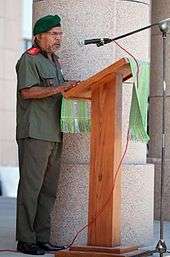
The constitution of East Timor states that the president is the supreme commander of the defence force and has the power to appoint the F-FDTL's commander and chief of staff. The Council of Ministers and National Parliament are responsible for funding the F-FDTL and setting policy relating to East Timor's security.[2] Cirilo José Cristovão serves as the current minister of Defence and Security, and Julio Tomas Pinto is the Secretary of State for Defense. Both men were sworn into these roles on 8 August 2012.[48] A Superior Council for Defence and Security was established in 2005 to advise the president on defence and security policy and legislation and the appointment and dismissal of senior military personnel. The council is chaired by the president and includes the prime minister, the defence, justice, interior and foreign affairs ministers, the heads of the F-FDTL and PNTL a national state security officer and three representatives from the national parliament. The council's role is not clear, however, and neither it nor the parliament served as a check against the decision to sack large numbers of F-FDTL personnel in 2006.[49] A parliamentary committee also provides oversight of East Timor's security sector.[50] Major General Lere Anan Timor is the current commander of the F-FDTL, and was appointed to this position on 6 October 2011.[51]
A small ministry of defence (which was renamed the Ministry of Defence and Security in 2007) was established in 2002 to provide civilian oversight of the F-FDTL. A lack of suitable staff for the ministry and the close political relationship between senior F-FDTL officers and government figures rendered this oversight largely ineffectual and retarded the development of East Timor's defence policy up to at least 2004.[52] The failure to institute effective civilian oversight of the F-FDTL also limited the extent to which foreign countries are willing to provide assistance to the F-FDTL[53] and contributed to the 2006 crisis.[54] As at early 2010 the Ministry of Defence and Security was organised into elements responsible for defence (including the F-FDTL) and security (including the PNTL), each headed by their own secretary of state. At this time the East Timorese Government was working to expand the ministry's capacity with assistance from UNMIT, but continuing shortages of qualified staff limited the extent to which the ministry could provide civilian oversight to the security sector.[55] Moreover, elements of the F-FDTL were continuing to resist civilian control over the security forces at this time, and the force had not opened itself to international scrutiny.[42]
Organisation
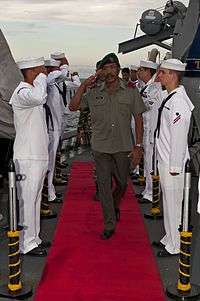
The F-FDTL is organised into a headquarters, a land component, a naval component and an air component.[1] Following its establishment the F-FDTL also had the "largest and most sophisticated" human intelligence network in East Timor, which was based on the clandestine resistance reporting networks built up during the Indonesian occupation.[56] However, in May 2008 the national parliament legislated to place the F-FTDL's intelligence branch under the authority of the head of the National Information Service.[57]
In 2011 F-FDTL had an authorised strength of 1,500 regular personnel and 1,500 reservists. It had not reached these totals as funding shortfalls prevented the reserve component from being formed and the Army's two regular battalions were under-strength.[58] While all the F-FDTL's personnel were initially FALINTIL veterans the force's composition has changed over time and few soldiers from the insurgency remain due to the force's narrow age requirement.[59] After the F-FDTL's 1st Battalion was established in 2001 recruitment was opened to all East Timorese above the age of 18, including women.[20] Few women have joined the F-FDTL, however, and as at February 2010 only seven percent of new recruits were female.[60][61]
Army
When initially established, the F-FDTL land force comprised two light infantry battalions, each with an authorised strength of 600 personnel.[62] As of 2004 each battalion had three rifle companies, a support company and a headquarters company.[63] Although the army is small, the guerrilla tactics employed by FALINTIL before the departure in 1999 of the Indonesian National Armed Forces were effective against overwhelming numbers and it has the potential to form a credible deterrent against invasion.[64] The Army's current doctrine is focused on low-intensity infantry combat tactics as well as counter-insurgency tasks.[58] Most of the force's training and operations are conducted at the section level, and company or battalion-sized exercises are rare.[65]
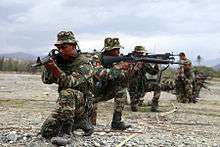
As of 2020 the Army's main elements remained two light infantry battalions.[1] These units are located in separate bases. As of 2004 the 1st Battalion was based at Baucau, with a contingent in the seaside coastline village of Laga.[66] In 2006 the 2nd Battalion was stationed at the Nicolau Lobato Training Centre near Metinaro.[67] Almost all of the 2nd Battalion's soldiers were dismissed during the 2006 crisis.[19] The other major Army units are a military police platoon and a logistic support company.[1] The 2020 edition of The Military Balance stated that the Army had 2,200 personnel.[1]
Logistics and service support is provided through Headquarters F-FDTL in Dili. The military police platoon polices the F-FDTL and performs traditional policing tasks, resulting in conflicting roles with the PNTL. The military police have also been responsible for presidential security since February 2007.[68] In 2010 the United States Embassy in Dili reported that the F-FDTL also planned to raise two engineer squadrons during that year; these two units were to have a total strength of 125 personnel.[69]
The F-FDTL is armed only with small arms and does not have any crew-served weapons. The 2007 edition of Jane's Sentinel stated that the F-FDTL had the following equipment in service: 1,560 M16 rifles and 75 M203 grenade launchers, 75 FN Minimi squad automatic weapons, 8 sniper rifles and 50 .45 M1911A1 pistols. A further 75 Minimis were to be ordered at that time. The majority of the F-FDTL's weapons were donated by other countries.[70] An assessment of East Timor's security forces published by the Centre for International Governance Innovation in 2010 stated that "F-FDTL weapons management and control systems, while superior to that of PNTL, are underdeveloped".[42]
Naval Component
The Naval Component of the F-FDTL was established in December 2001 when Portugal transferred two small Albatroz-class patrol boats from the Portuguese Navy. Its establishment was not supported by the King's College study team, the UN, or East Timor's other donor countries on the grounds that East Timor could not afford to operate a naval force.[16] The role of the naval component is to conduct fishery and border protection patrols and ensure that the maritime line of communication to the Oecussi enclave remains open. All of the force's warships are based at Hera Harbour, which is located a few kilometres east of Dili.[71] Under the Force 2020 plan the naval component may eventually be expanded to a light patrol force equipped with corvette-sized ships and landing craft.[72]
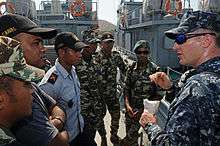
On 12 April 2008 East Timor signed a contract for two new Chinese-built 43-metre Type-62 class patrol boats. These ships were to replace the Albatroz-class vessels and to be used to protect East Timor's fisheries. The contract for the ships also involved 30 to 40 East Timorese personnel being trained in China.[73][74] The two new patrol boats arrived from China in June 2010, and were commissioned as the Jaco-class on the eleventh of the month.[75][76] In November 2010 it was reported that East Timor would order a further two patrol boats from South Korea.[77] In the event, three ex-Republic of Korea Navy Chamsuri class patrol boats were donated, and these entered service with the naval component on 26 September 2011.[78] The East Timorese government also ordered two fast patrol boats from the Indonesian company PT Pal in March 2011 for the price of $US40 million.[79]
The 2020 edition of the IISS Military Balance listed the naval component's size as 80 personnel.[1] The 2011 edition of Jane's Sentinel put the strength of the naval component at 250; this source also stated that recruitment for an approximately 60-person strong Marine unit began in 2011 from existing naval component personnel, members of the Army and civilians. The Marines will serve as a Special Operations force.[80]
In 2017 Timor Leste accepted an offer of two new Guardian-class patrol boats and associated training and logistics assistance from the Australian Government. The vessels are scheduled to be delivered in 2023.[81]
| Current Vessels | Origin | Class | Type | Notes |
|---|---|---|---|---|
| NRTL Jaco (P 211) | China | Jaco | Patrol Boat | Commissioned June 2010 |
| NRTL Betano (P 212) | China | Jaco | Patrol Boat | Commissioned June 2010 |
| NRTL Kamenassa (P 1??) | South Korea | Chamsuri | Patrol Boat | Commissioned 26 September 2011 |
| NRTL Dili (P 1??) | South Korea | Chamsuri | Patrol Boat | Commissioned 26 September 2011 |
| NRTL Hera (P 1??) | South Korea | Chamsuri | Patrol Boat | Commissioned 26 September 2011 |
| Former Vessels | Origin | Class | Type | Notes |
| NRTL Oecusse (P 101) | Portugal | Albatroz | Patrol Boat | ex NRP Albatroz (P 1012), transferred in 2002 |
| NRTL Atauro (P 102) | Portugal | Albatroz | Patrol Boat | ex NRP Atauro (P 1163), transferred in 2002 |
| Future Vessels | Origin | Class | Type | Notes |
| Yet to be named | Australia | Guardian | Patrol Boat | Scheduled for delivery in 2023 |
| Yet to be named | Australia | Guardian | Patrol Boat | Scheduled for delivery in 2023 |
Naval Bases
Currently only operate the Hera Naval Base. Australia is paying for the construction of a new wharf that will enable operations of the two Guardian-class patrol boats.[82]
Air Component
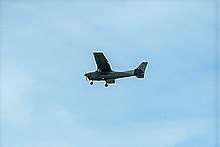
As of 2020 the F-FDTL's Air Component operated a single Cessna 172 aircraft.[1]
Ranks
The military ranks of the F-FDTL are similar to the military ranks of the Portuguese Armed Forces.[83]
Defence expenditure and procurement
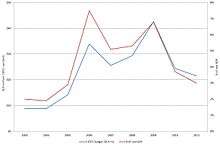
Total defence expenditure for East Timor in 2018 was $US29.1 million. This represented 2.7 percent of gross domestic product (GDP).[85]
Most of the F-FDTL's weapons and other equipment have been provided by foreign donors, and this is likely to remain the case in the future.[4][86] The East Timor government has used some of the revenue it earns from the country's oil and gas sector to purchase military equipment, however.[4] No military production took place in East Timor as of 2011, and in 2020 the IISS noted that "maintenance capacity is unclear and the country has no traditional defence industry".[1][87]
Funding shortfalls have constrained the development of the F-FDTL. The government has been forced to postpone plans to form an independent company stationed in the Oecussi enclave and two reserve infantry battalions. These units formed an important part of the King's College report's option 3 force structure and their absence may have impacted on East Timor's defence policy.[88] As of 2011 the government was yet to announce what, if any, reserve units would be formed, though provisions for such units had been included in legislation.[89]
Foreign defence relations
While the UN was reluctant to engage with the F-FDTL, several bilateral donors have assisted the force's development. Australia has provided extensive training and logistical support to the F-FDTL since it was established, and currently provides advisors who are posted to the F-FDTL and Ministry of Defence and Security. Portugal also provides advisors and trains two naval officers each year in Portugal. China provided US$1.8 million in aid to the F-FDTL between 2002 and 2008 and agreed to build a new US$7 million headquarters for the force in late 2007. East Timor is one of Brazil's main destinations for aid and the Brazilian Army is responsible for training the F-FDTL's military police unit (Maubere Mission). The United States also provides a small amount of assistance to the F-FDTL through the State Department's International Military Education and Training Program. While Malaysia has provided training courses and financial and technical aid, this assistance was suspended after the 2006 crisis.[90] As of 2010, Portugal provided the F-FDTL with basic and advanced training while Australia and other nations provided training in specialised skills.[69] East Timor and Portugal signed a defence cooperation treaty in 2017 which will remain in force until 2022. Australian and US support for the F-FDTL had been reduced to only occasional training by 2020.[1] In 2016 the East Timorese government posted three F-FDTL members to serve overseas as observers with the United Nations Mission in South Sudan.[47]
East Timor and Indonesia have sought to build friendly relations since 2002. While movements of people and drug smuggling across their international border has caused tensions, both countries have worked with the UN to improve the security situation in the region.[91] The East Timorese and Indonesian governments signed a defence agreement in August 2011 which aims to improve co-operation between their national militaries. The Timor Leste-Indonesia Defense Joint Committee was also established at this time to monitor the agreement's implementation.[91][92]
East Timor ratified the Nuclear Non-Proliferation Treaty, Biological and Toxin Weapons Convention and Chemical Weapons Convention in 2003. The East Timorese Government has no plans to acquire nuclear, biological or chemical weapons.[93] The country also became a party to the Ottawa Treaty, which bans anti-personnel mines, in 2003.[94]
Notes
- The King's College report estimated that a military of 1,500 regulars and 1,500 reservists would cost approximately one percent of East Timor's GDP and that this was the highest level of military expenditure the country could sustain.[8]
References
Citations
- International Institute for Strategic Studies 2020, p. 317.
- Rees (2004), pp. 7–9
- Rees (2004), p. 14
- Patrikainen et al. (2011), p. 140
- Wainwright (2002), p. 23
- The Centre for Defence Studies, King's College, London. Paragraph 205.
- The Centre for Defence Studies, King's College, London. Paragraphs 7.2 to 7.4
- The Centre for Defence Studies, King's College, London. Paragraphs 7.4 and 158.
- Fawthrop and Harris (2001), p. 37
- Sheridan, Greg (9 August 2007). "Fretilin still a stranger to democracy". The Australian. Archived from the original on 28 August 2007. Retrieved 9 August 2007.
- Sedra et al. (2010a), p. 5
- Smith (2005), pp. 31–32
- Ball (2002), p. 180
- Rees (2004), p. 31
- McDonald, Hamish (20 April 2002). "East Timor's Tiny Army Aims High". Reproduced on the East Timor Action Network's website. The Sydney Morning Herald. Retrieved 3 February 2008.
- Jane's Sentinel Security Assessment – Southeast Asia. Issue 20 – 2007, p. 148
- Dobbins et al. (2013), p. 139
- Rees (2004), pp. 47–49
- International Crisis Group (2008), p. 5
- Jane's Sentinel Security Assessment – Southeast Asia. Issue 20 – 2007, p. 116
- Rees (2004), pp. 20–21
- Horta (2006)
- Rees (2004), pp. 32–33
- International Crisis Group (2008), p. 2
- Robinson (2011), p. 1011
- "Aust to send troops to E Timor". ABC News. 24 May 2006. Retrieved 24 May 2012.
- United Nations Independent Special Commission of Inquiry for Timor-Leste (2007), p. 21
- United Nations Independent Special Commission of Inquiry for Timor-Leste (2007), pp. 21–30 and International Crisis Group (2008), p. 2
- United Nations Independent Special Commission of Inquiry for Timor-Leste (2007), pp. 31–33
- "UN commission of inquiry issues report on violent crisis that shook Timor-Leste" (Press release). United Nations. 17 October 2006. Retrieved 1 September 2007.
- International Crisis Group (2008), p. i
- Burton (2007), p. 101
- International Crisis Group (2008), p. 8
- Dodd, Mark (8 June 2007). "Secret missile plan for East Timor". The Australian. Archived from the original on 11 July 2007. Retrieved 10 August 2007.
- The Centre for Defence Studies, King's College, London. Paragraphs 7.2 and 205–212.
- International Crisis Group (2008), pp. 6, 9
- Dodd, Mark (6 August 2007). "Timor military blueprint unrealistic: Downer". The Australian. Archived from the original on 18 September 2012. Retrieved 10 August 2007.
- "Force 2020 is important for the East Timor Government" (Press release). East Timor Ministry of Defence. 3 July 2007. Retrieved 11 August 2007.
- "East Timor's window of opportunity". BBC News. 10 March 2008. Retrieved 6 April 2008.
- UNMIT (2008), pp. 2, 5–6
- UNMIT (2009), p. 2
- Sedra et al. (2010), p. 11
- Sedra et al. (2010a), pp. 11–12
- Patrikainen et al. (2011), p. 141
- Robinson (2011), p. 1014
- International Security Sector Advisory Team 2016.
- International Institute for Strategic Studies 2016, p. 296.
- "TMR swears in the new cabinet ministers". Press release. Office of the President. Archived from the original on 25 May 2013. Retrieved 15 August 2012.
- Burton (2007), pp. 100–101
- UNMIT (2010), p. 11
- UNMIT (2011), p. 38
- Rees (2004), pp. 11–14
- Rees (2004), p. 28
- UNMIT (2006), p. 17
- UNMIT (2010), pp. 11 and 14
- Rees (2004), p. 56
- UNMIT (2008), p. 8
- Patrikainen et al. (2011), p. 143
- La'o Hamutuk Bulletin (2005)
- UNMIT (2006), p. 29
- UNMIT (2010), p. 14
- Ball (2002), pp. 179–180
- Rees (2004), pp. 28–29
- Wainwright (2002), pp. 34
- Doran, Mark (21 May 2015). "Timorese take to training". Army. p. 14. Retrieved 18 May 2015.
- Rees (2004), p. 29.
- Lowry (2006), p. 4 and Rees (2004), pp. 29–31
- International Crisis Group (2008), p. 15
- Embassy of the United States, Dili (2010), p. 4
- Jane's Sentinel Security Assessment – Southeast Asia. Issue 20 – 2007, pp. 146, 152
- Saunders (2011), p. 203
- Wertheim, Eric (2008). "World Navies in Review". Proceedings. March 2008. United States Naval Institute. p. 16.
- Dodd, Mark (16 April 2008). "Alarm at China's influence in Timor". The Australian. Archived from the original on 9 May 2008. Retrieved 16 April 2008.
- Storey, Ian (2009). "China's Inroads into East Timor". China Brief. Washington DC: The Jamestown Foundation. 9 (4).
- McGuirk, Rod (23 June 2010). "East Timorese president prefers 'fake Gucci' warships from China to Western military hardware". The Canadian Press. Retrieved 18 July 2010.
- "Ceremony for the Delivery of New Patrols Vessels, Jaco Class, to the F-FDTL Naval Force". Government of Timor-Leste. Retrieved 6 August 2010.
- Murdoch, Lindsay (15 November 2010). "Timorese tweak Canberra with patrol boat buys". The Sydney Morning Herald. Retrieved 29 November 2010.
- Mazumdar, Mrityunjoy (4 October 2011). "East Timor commissions ex-South Korean patrol craft". Jane's Navy International.
- Patrikainen et al. (2011), p. 149
- Patrikainen et al. (2011), p. 146
- Dominguez, Gabriel (6 November 2017). "Timor-Leste to receive two Pacific Patrol Boats in 2023". Jane's Defence Weekly. Archived from the original on 10 January 2018. Retrieved 22 January 2018.
- Press, Rod McGuirk, The Associated (30 August 2019). "Aussies to revamp East Timor naval base". Navy Times. Retrieved 18 May 2020.
- "Timor-Leste Defence Force". Uniforminsignia.org. Retrieved 20 February 2018.
- Defence Intelligence Organisation (2011), p. 12
- Defence Intelligence Organisation 2019, p. 26.
- Defence Intelligence Organisation 2019, p. 27.
- Patrikainen et al. (2011), p. 150
- Rees (2004), p. 27
- International Crisis Group (2011), pp. 12–13
- International Crisis Group (2008), pp. 12–13
- Dobbins et al. (2013), p. 141
- Santosa, Novan Iman (22 August 2011). "RI, Timor Leste ink defense deals". The Jakarta Post. Retrieved 23 April 2015.
- Patrikainen et al. (2011), p. 154
- "Convention on the Prohibition of the Use, Stockpiling, Production and Transfer of Anti-Personnel Mines and on their Destruction". United Nations Treaty Collection. United Nations. Retrieved 18 December 2011.
Works consulted
- Books and reports
- Amnesty International (2003). "Timor Leste: Briefing to Security Council Members on policing and security in Timor-Leste" (PDF).
- Burton, Cynthia (2007). "Security sector reform: current issues and future challenges". In Damien Kingsbury and Michael Leach (ed.). East Timor: beyond independence. Melbourne: Monash University Press. ISBN 978-1-876924-49-2.
- The Centre for Defence Studies, King's College, London (2000). Independent Study on Security Force Options and Security Sector Reform for East Timor. London.CS1 maint: multiple names: authors list (link)
- Defence Intelligence Organisation (2019). "Defence Economic Trends in the Asia-Pacific 2019" (PDF). Defence Economic Trends in the Asia-Pacific. Department of Defence. ISSN 1835-3878.CS1 maint: ref=harv (link)
- Dobbins, James; et al. (2013). Overcoming Obstacles to Peace : Local Factors in Nation-Building. Santa Monica, California: RAND Corporation. ISBN 978-0-8330-7861-2.
- Embassy of the United States, Dili (2010). "U.S. Military Engagement: 2009 in Review". Embassy of the United States. Archived from the original on 27 May 2010. Retrieved 18 July 2010.
- Government of East Timor (2007). Força 2020. Hosted on the East Timor and Indonesia Action Network's website. Government of East Timor. Retrieved 7 August 2007. This publication is also available from the East Timor Ministry of Defence and Security's website.
- Jane's Sentinel Security Assessment – Southeast Asia. Issue 20 – 2007. Coulsdon: Jane's Information Group.
- Horta, Loro (2006). "Young and Wild. Timor Leste's troubled military" (PDF). IDSS Commentaries. Institute of Defence and Strategic Studies, Nanyang Technological University. Archived from the original (PDF) on 27 September 2007. Retrieved 1 September 2007.
- International Crisis Group (2006). "Resolving Timor-Leste's Crisis". International Crisis Group. Archived from the original on 15 August 2007. Retrieved 18 August 2007.
- International Crisis Group (2007). "Timor-Leste's Parliamentary Elections". International Crisis Group. Archived from the original on 14 August 2007. Retrieved 18 August 2007.
- International Crisis Group (2008). "Timor-Leste: Security Sector Reform". International Crisis Group. Archived from the original on 23 January 2008. Retrieved 19 January 2008.
- International Crisis Group (2011). Timor-Leste's Veterans: An Unfinished Struggle? (PDF). Brussels: International Crisis Group. Archived from the original (PDF) on 3 December 2011.
- International Institute for Strategic Studies (IISS) (2013). The Military Balance 2013. London: IISS. ISSN 0459-7222.
- International Institute for Strategic Studies (2016). The Military Balance 2016. Abingdon, UK: Routledge. ISBN 9781857438352.CS1 maint: ref=harv (link)
- International Institute for Strategic Studies (2020). "The Military Balance 2020". Military Balance. Abingdon, UK: Routledge. ISSN 1479-9022.CS1 maint: ref=harv (link)
- International Security Sector Advisory Team (27 October 2016). "Timor-Leste SSR Background Note". DCAF.CS1 maint: ref=harv (link)
- Lowry, Bob (2007). "After the 2006 crisis: Australian interests in Timor-Leste". Strategic Insights. Australian Strategic Policy Institute. 38. Archived from the original on 21 July 2008.
- Patrikainen, Maria; et al. (2011). Jane's Sentinel Country Risk Assessments: Southeast Asia Issue Twenty-nine – 2011. Coulsdon: IHS Jane's. ISSN 1754-9264.
- "On the Findings of the Independent Inquiry Commission (IIC) for the FALINTIL-FDTL" (Press release). President of East Timor. 24 August 2004. Retrieved 23 November 2007.
- Rees, Edward (April 2004). "Under Pressure v Forças de Defesa de Timor Leste. Three Decades of Defence Force Development in Timor Leste 1975–2004". Working Paper. Geneva Centre for the Democratic Control of Armed Forces. 139.
- República Democrática de Timor-Leste (2015). "State Budget 2015 Budget Overview Book 1" (PDF). Government of Timor Leste.
- Saunders, Stephen (editor) (2011). Jane's Fighting Ships Vol. 114, 2011–2012. Coulsdon, UK: IHS Global. ISBN 978-0-7106-2959-3.CS1 maint: extra text: authors list (link)
- Sedra, Mark; et al. (2010). "Security Sector Reform Monitor: Timor-Leste No. 1" (PDF). Centre for International Governance Innovation. Retrieved 3 August 2012.
- Sedra, Mark; et al. (2010a). "Security Sector Reform Monitor: Timor-Leste No. 2" (PDF). Centre for International Governance Innovation. Archived from the original (PDF) on 16 October 2015. Retrieved 3 August 2012.
- United Nations Independent Special Commission of Inquiry for Timor-Leste (2007). "Report of the United Nations Independent Special Commission of Inquiry for Timor-Leste" (PDF). United Nations High Commissioner for Human Rights.
- United Nations Integrated Mission in Timor-Leste (UNMIT) (2006). "Report of the Secretary-General. S/2006/628. 8 August 2006. Covering major developments since the 20 April report and presenting recommendations on the future UN role in Timor-Leste" (PDF). Retrieved 12 August 2007.
- United Nations Integrated Mission in Timor-Leste (UNMIT) (2007). "Report on human rights developments in Timor-Leste August 2006 – August 2007" (PDF). Archived from the original (PDF) on 20 December 2007. Retrieved 18 November 2007.
- United Nations Integrated Mission in Timor-Leste (UNMIT) (2008). "Report of the Secretary-General on the United Nations Integrated Mission in Timor-Leste (for the period from 8 January to 8 July 2008)" (PDF). United Nations. Retrieved 6 September 2008.
- United Nations Integrated Mission in Timor-Leste (UNMIT) (2009). "Report of the Secretary-General on the United Nations Integrated Mission in Timor-Leste (Covering the period from 9 July 2008 to 20 January 2009)" (PDF). United Nations. Archived from the original (PDF) on 9 October 2011. Retrieved 6 December 2009.
- United Nations Integrated Mission in Timor-Leste (UNMIT) (2009a). "Report of the Secretary-General on the United Nations Integrated Mission in Timor-Leste (for the period covering 21 January to 23 September 2009)" (PDF). United Nations. Archived from the original (PDF) on 9 October 2011. Retrieved 6 December 2009.
- United Nations Integrated Mission in Timor-Leste (UNMIT) (2010). "Report of the Secretary-General on the United Nations Integrated Mission in Timor-Leste (for the period from 24 September 2009 to 20 January 2010)". United Nations. Retrieved 6 August 2010.
- UNMIT (2011). "Governance of the Democratic Republic of Timor Leste : Accountability Mechanism of Key Institutions. Second Edition" (PDF). United Nations. Archived from the original (PDF) on 5 February 2015. Retrieved 15 August 2012.
- Wainwright, Elsina (2002). New Neighbour, New Challenge: Australia and the Security of East Timor. Canberra: Australian Strategic Policy Institute. ISBN 1-920722-00-9. Archived from the original on 31 August 2007.
- Journal articles
- Ball, Desmond (October 2002). "The Defence of East Timor: A Recipe For Disaster?". Pacifica Review. 14 (3): 175–189. doi:10.1080/1323910022000023147.
- Tom Fawthrop & Paul Harris (2001). "East Timor prepares for post-independence security threats". Janes Intelligence Review. October 2001. Coulsdon: Jane's Information Group. pp. 36–38. ISSN 1350-6226.
- The International Institute for Strategic Studies (IISS) (2006). "Turmoil in Timor Leste". Strategic Comments. 12 (5). Archived from the original on 14 November 2007. Retrieved 6 November 2007.
- La'o Hamutuk (2005). "Transformation of FALINTIL into F-FDTL". The La'o Hamutuk Bulletin. 6 (1–2: April 2005). Retrieved 3 February 2008.
- Lowry, Bob (2006). National security policy and structure: Police, military and intelligence. Beyond the crisis in Timor-Leste. Canberra: Australian National University Development Studies Network. Archived from the original on 19 August 2006.
- Robinson, Geoffrey (November 2011). "East Timor Ten Years On: Legacies of Violence". The Journal of Asian Studies. 70 (4): 1007–1021. doi:10.1017/S0021911811001586.
- Smith, Anthony L. (June 2005). "Constraints and Choices: East Timor as a Foreign Policy Actor" (PDF). New Zealand Journal of Asian Studies. 7 (1): 15–36. Retrieved 13 November 2007.
External links
| Wikimedia Commons has media related to Military of East Timor. |